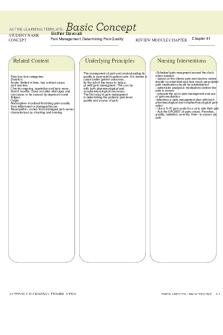ATI Basic Concept- urgent v nonurgent acute v chronic PDF

| Title | ATI Basic Concept- urgent v nonurgent acute v chronic |
|---|---|
| Author | Raven Trickett |
| Course | lpn to rn |
| Institution | Eastern Gateway Community College |
| Pages | 1 |
| File Size | 44.5 KB |
| File Type | |
| Total Downloads | 55 |
| Total Views | 142 |
Summary
ATI assignments for maternal newborn summer semester...
Description
ACTIVE LEARNING TEMPLATE:
Basic Concept
Trickett ST UDENT NAME Raven _____________________________________ Acute v Chronic urgent v nonurgent stable v unstable CONCEPT ______________________________________________________________________________
Related Content
Underlying Principles
(E.G., DELEGATION, LEVELS OF PREVENTION, ADVANCE DIRECTIVES)
Evidence Based Practice Prioritization and Time Management Teamwork Assigning, Delegating, and Supervising Managing Client Care Maslow's hierarchy
Managing care
REVIEW MODULE CHAPTER ___________
Nursing Interventions WHO? WHEN? WHY? HOW?
A client who has an acute problem takes priority over a client who has chronic problem A client who has an urgent need takes priority over a client has a nonurgent deep A client who has unstable findings takes priority over a client who has stable findings
First: Airway:-Identify an airway concern (obstruction, stridor) -Establish a patent airway if indicated-Recognize that 3 to 5 min without oxygen causes irreversible brain damage secondary to cerebral anoxia Second: Breathing -Assess the effectiveness of breathing (apnea, depressed respiratory rate)-Intervene as needed (reposition, administer naloxene) Third: Circulation-Identify circulation concern (hypotension, dysrhythmia, inadequate cardiac output, compartment syndrome)-Institute actions to reverse or minimize circulatory alteration Fourth: Disability-Assess for current or evolving disability (neurological deficits, stroke in evolution)-Implement actions to slow down development of disability Fifth: Exposure-Remove the client's clothing to allow for a complete assessment or resuscitation-Implement measures to reduce the risk for hypothermia (provide warm blankets and IV solutions or use cooling measures for clients exposed to extreme heat
ACTIVE LEARNING TEMPLATES...
Similar Free PDFs

ATI - Basic Concept - template
- 1 Pages

Basic Concept form ati
- 1 Pages

Advocacy - ATI Basic Concept
- 1 Pages

Acute and chronic gout
- 4 Pages

ATI - Basic Concept 2 - template
- 1 Pages

Basic Concept 1 - ATI work
- 1 Pages

Acute pancreatitis concept map
- 7 Pages
Popular Institutions
- Tinajero National High School - Annex
- Politeknik Caltex Riau
- Yokohama City University
- SGT University
- University of Al-Qadisiyah
- Divine Word College of Vigan
- Techniek College Rotterdam
- Universidade de Santiago
- Universiti Teknologi MARA Cawangan Johor Kampus Pasir Gudang
- Poltekkes Kemenkes Yogyakarta
- Baguio City National High School
- Colegio san marcos
- preparatoria uno
- Centro de Bachillerato Tecnológico Industrial y de Servicios No. 107
- Dalian Maritime University
- Quang Trung Secondary School
- Colegio Tecnológico en Informática
- Corporación Regional de Educación Superior
- Grupo CEDVA
- Dar Al Uloom University
- Centro de Estudios Preuniversitarios de la Universidad Nacional de Ingeniería
- 上智大学
- Aakash International School, Nuna Majara
- San Felipe Neri Catholic School
- Kang Chiao International School - New Taipei City
- Misamis Occidental National High School
- Institución Educativa Escuela Normal Juan Ladrilleros
- Kolehiyo ng Pantukan
- Batanes State College
- Instituto Continental
- Sekolah Menengah Kejuruan Kesehatan Kaltara (Tarakan)
- Colegio de La Inmaculada Concepcion - Cebu








